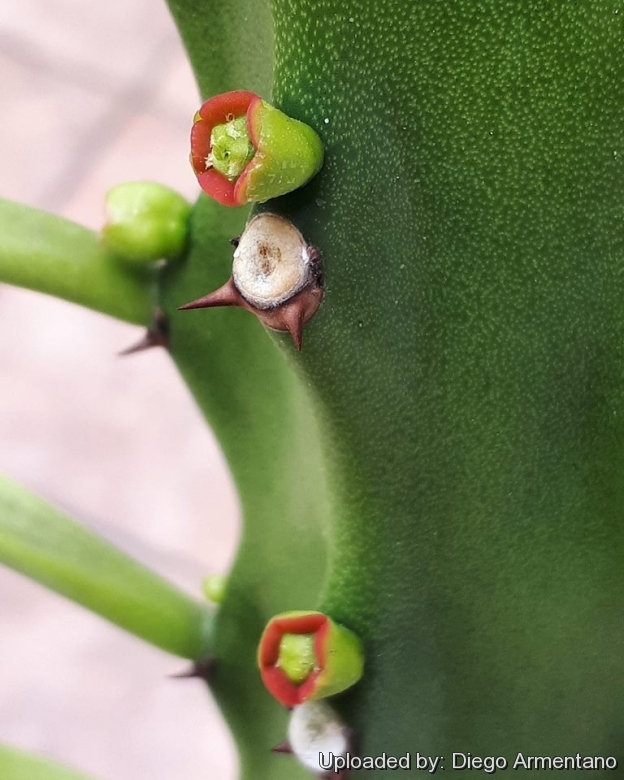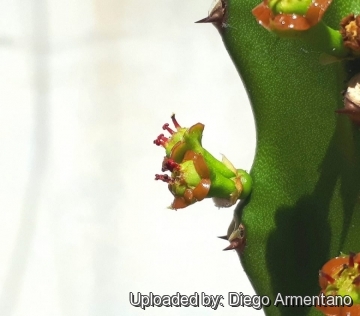
Elaeophorbia drupifera Photo by: Diego Armentano
Origin and Habitat: Western tropical Africa from Ghana Eeast to Cameroon and West to Uganda
Altitude range: Up to 700 metres above sea level.
Habitat and ecology: Elaeophorbia drupiferaSN|35346]]SN|35346]] is common on flooded coastal plains in open situations and in forest edges, occasionally in rain-forest, on brown-black humid soil with shrub, near termitaria. The fruits are often eaten by browsing antelopes.
Synonyms:
See all synonyms of Elaeophorbia drupifera
back
Accepted name in llifle Database:Elaeophorbia drupifera (Thonn.) StapfHooker's Icon. Pl. 29: t. 2823 1906.Synonymy: 5
back
Description: Elaeophorbia drupiferaSN|35346]]SN|35346]] is a glabrous, monoecious tree with a large rounded crown. Branched low down in open situations, but with a long clear woody bole in forest; 12 - 22 m high or more high and 60 cm in diameter. The fleshy branches containing abundant, very caustic, white latex.
It produces small greenish flowers that are displaced by a yellow-orange fleshy fruit.
Stems: Young branches rather obscurely 4–6- (often 5-) angled, fleshy, becoming cylindrical and woody with age, armed at the angles with pairs of spines.
Leaves: Alternate, crowded at the branches tips, large, thick and fleshy, glabrous, deciduous with a horny spine-shield at the base of the petiole bearing a pair of short spines and minute stipules. Spine-shield obtusely triangular, to 8 x 9 mm, almost enclosing the large leaf-scar and flowering eye above. Petiole 8-25 mm long, stout. Blade 7-28 cm long, 4,5-10 cm broad, usually elongated cuneate-oblong, obovate or cuneately obcordate, obtusely rounded, acutely and somewhat abruptly cuneate into the petiole from 18-25 mm above the base or gradually tapering into it, margin entire, midrib prominent beneath. Stipules a pair of stout spines 2-4 mm long; these continue to grow after the leaf has fallen and become very conspicuous as the cicatrices are very plainly marked.
Inflorescence: Axillary with cyathia in dichotomous cymes. Peduncles usually 3 together, sometimes solitary, in the axils of the young leaves, 12-45 mm long, simple or once forked, with a sessile cyathium in the fork and branches 18-25 mm long, moderately stout, glabrous. Bracts opposite, persistent, shorter and than close under the cyathia, 3-4 mm long, 3-5 mm broadly deltoid, ar broadly ovate, acute or obtuse, concave, keeled down the back, glabrous, with buds in their axils.
Flowers (cyathia). A shallowly cup-like, sessile, involucre, about 3 mm deep and 9-12 mm in diameter, with 5 spreading nectar-glands alternating with and outside of 5 toothed lobes 1.5-2.5 mm long, 4-6 mm broad, touching, brownish-yellow, enclosing a dense cushion-like mass of stamens (male flowers) and bracteoles, with or without a central ovary (female flower). Stamens many, well-exserted. Ovary erect, without a perianth and merging into the stout pedicels which does not exceed the stamens, without a calyx, glabrous. Style very short (c. 1.5 mm long) with 3 thickened, subsessile, bifid stigmas, rugose.
Fruits drupes): Subsessile, shortly exserted beyond the remains of the stamens, obovoid or subglobose, green turning yellow, varying in size from that of a cherry up to that of a walnut (c. 50 x 35 mm), obtuse, with a thick fleshy exocarp, a hard woody 3-celled endocarp, indehiscen with a pore at the base and another near the apex of each cell.
Seeds: Ovoid with acute apex, 7 mm long, 4.5 mm broad, smooth, without a caruncle.
Bibliography: Major references and further lectures
1) J. G. Baker, with additions by C. H. Wright, “Flora of Tropical Africa”, Vol 6, Part 1, 1913
2) "Flora of West Tropical Africa", Vol 1, Part 2, web: https://plants.jstor.org/stable/10.5555/al.ap.flora.fwta2374?searchUri=filter%3Dname%26so%3Dps_group_by_genus_species%2Basc%26Query%3DEuphorbia%2Bdrupifera
3) Checklist Flow. Pl. Sub-Saharan Africa : 279 (2006).
4) Umberto Quattrocchi, “CRC World Dictionary of Medicinal and Poisonous Plants: Common Names, Scientific Names, Eponyms, Synonyms, and Etymology” (5 Volume Set), CRC Press, 19 April 2016
5) Urs Eggli "Illustrated Handbook of Succulent Plants: Dicotyledons" Volume 2. Springer, 2002
6) William A. Emboden, “Narcotic plants” Macmillan, 1979
 Elaeophorbia drupifera Photo by: Diego Armentano
Elaeophorbia drupifera Photo by: Diego ArmentanoSend a photo of this plant.The gallery now contains thousands of pictures, however it is possible to do even more. We are, of course, seeking photos of species not yet shown in the gallery but not only that, we are also looking for better pictures than those already present.
Read More... Cultivation and Propagation: Traditional uses: The fruit of Elaeophorbia drupiferaSN|35346]]SN|35346]] is crushed with the leaves, it serves as a fish poison. The sap of this tree is quite caustic and if rubbed into the eyes, results in permanent blindness. For centuries it has been used in Africa to cure scorpion stings, warts, ringworm, wounds and sores. It is also added to eggs as a purgative. E. drupifera is sometimes planted as a fetish tree in Sudan.










